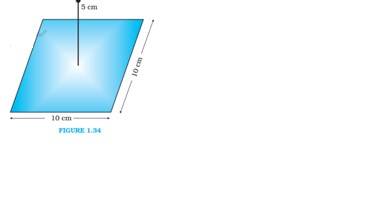Physics Ncert Solutions Class 12th
Get insights from 1.2k questions on Physics Ncert Solutions Class 12th, answered by students, alumni, and experts. You may also ask and answer any question you like about Physics Ncert Solutions Class 12th
Follow Ask QuestionQuestions
Discussions
Active Users
Followers
New answer posted
5 months agoContributor-Level 10
10.20 Weak radar signals sent by a low flying aircraft can interfere with the TV signal received by the antenna. Hence, TV signal may get distorted, resulting in shaking of picture on the TV.
This is because superposition follows from the linear character of a differential equation that governs wave motion. If and are the solutions of the second order wave equation, then any linear combination of and will also be the solution of the wave equation.
New answer posted
5 months agoContributor-Level 10
10.19 Wavelength of the light beam, = 500 nm = 500 m
Distance of the screen from the slit, D = 1 m
Distance of the first minimum from the centre of the screen, x = 2.5 mm = 2.5 m
Let the width of the slit be = d
From the equation
we get d =
= 2 m = 0.2 mm
Hence, the width of the slot is 0.2 mm
New answer posted
5 months agoContributor-Level 10
10.18 Distance between the towers, d = 40 km
Height of the line joining the hills, h = 50 m
Thus, the radial spread of the radio wave should not exceed 40 km
Since the hill is located halfway between the towers,
Fresnel's distance = = 20 km = 2
Aperture can be taken as a = h = 50 m
Fresnel's distance is given by the relation,
= or
= = 0.125 m = 12.5 cm
Therefore, the wavelength of the radio wave is 12.5 cm
New answer posted
5 months agoContributor-Level 10
10.17 If the width of the slit is made double the original width, then the size of the central diffraction band reduces to half and the intensity increases up to four times.
The interference pattern in a double-slit experiment is modulated by diffraction from each slit. The pattern is the result of the interference of the diffracted wave from each slit.
This is because light waves are diffracted from the edge of the circular obstacle, which interferes constructively at the centre of the shadow. This constructive interference produces a bright spot.
Bending of waves by obstacles by a large angle is possible when the size of the obstacle is
New answer posted
5 months agoContributor-Level 10
10.16 Wavelength of the light used, 6000 nm = 600 m
Angular width of the fringe, = 0.1 rad
Angular width of a fringe is related to slit spacing (d) as
d = = = 3.44 m
New answer posted
5 months agoContributor-Level 10
10.15 Sound waves can propagate only through a medium. The two given situations are not scientifically identical because the motion of an observer relative to a medium is different in the two situations. Hence, the Doppler formulas for the two situations cannot be the same.
In case of light waves, sound can travel in a vacuum. In a vacuum, the above two cases are identical because the speed of light is independent of the motion of the observer and the notion of the source. When light travels in a medium, the above two cases are not identical because the speed of light depends on the wavelength of the medium.
New answer posted
5 months agoContributor-Level 10
1.19 Net electric flux ( ) through the cubic surface is given by
=
where = Permittivity of free space = 8.854 *
q= 2.0 μC
=
New answer posted
5 months agoContributor-Level 10
10.14 The speed of light in vacuum (3
is a universal constant. It is not affected by the motion of the source, the observer, or both. Hence, the given factor does not affect the speed of light in a vacuum.
Out of these 5 factors, the speed of light in a medium depends on the wavelength of light in that medium.
New answer posted
5 months agoContributor-Level 10
10.13

Let an object at O be placed in front of a plane mirror MO' at a distance r. A circle is drawn from the centre (O) such that it just touches the plane mirror at point O'.
According to Huygens's principle, XY is the wave front of incident light.
If the mirror is absent, then a similar wave front X'Y' (as XY) would form behind O' at a distance r, as shown in the figure.

X'Y' can be considered as a virtual reflected ray for the plane mirror.
Hence, a point object placed in front of the plane mirror produces a virtual image whose distance from the mirror is equal to the object distance (r).
New answer posted
5 months agoContributor-Level 10
1.18 The square can be considered as one face of a cube of edge 10 cm with a centre where charge q is placed.
According to Gauss's theorem for a cube, total electric flux is through all its six faces.
We have q = +10
Hence, =
Taking an Exam? Selecting a College?
Get authentic answers from experts, students and alumni that you won't find anywhere else
Sign Up on ShikshaOn Shiksha, get access to
- 65k Colleges
- 1.2k Exams
- 682k Reviews
- 1800k Answers

